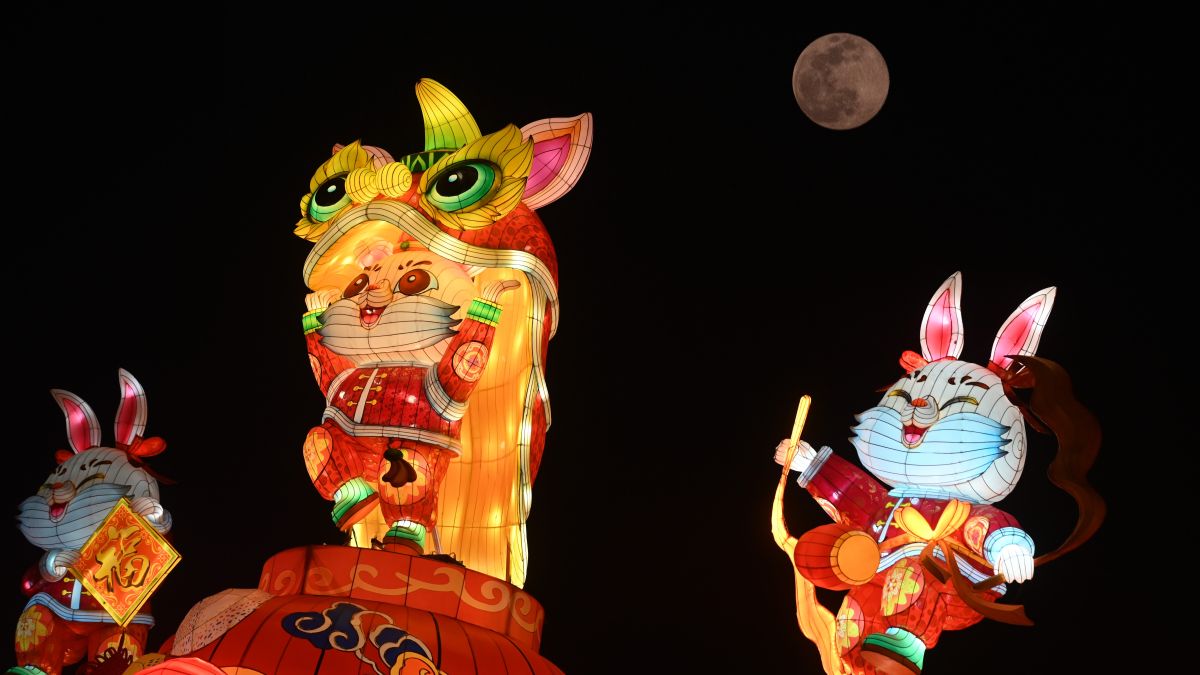The full moon of February shone in stunning photos across the world.
From celebrants of China’s Lantern Festival that honored the first full moon of the Chinese new year, to astronauts on the International Space Station, the full Snow Moon turned heads and shone in photos despite being the smallest “micromoon” of 2023.
The full moon of February, called the Snow Moon in some Native American cultures, occurred in the eastern U.S. at 1:28 p.m. (1828 GMT) on Sunday (Feb. 5), per the U.S. Naval Observatory (opens in new tab) . In New York City, the was visible at 5:10 p.m. — about eight minutes before sunset, meaning it was visible at the same time in the sky as the sun.
Related: February full moon 2023: The Snow Moon rises with Jupiter, Mars and Orion
If you’re looking for a telescope or binoculars to observe the next full moon, our guides for the best binoculars deals and the best telescope deals now can help. Our best cameras for astrophotography and best lenses for astrophotography can also help you prepare to capture the next skywatching sight on your own.
Fancy taking a more in-depth moonlit tour of our rocky companion? Our ultimate guide to observing the moon will help you plan your next skywatching venture whether it be exploring the lunar seas, mountainous terrain, or the many craters that blanket the landscape. You can also see where astronauts, rovers and landers have ventured with our Apollo landing sites observing guide.
The Full Snow Moon rises over the edgeNYC outdoor observation deck on the top of 50 Hudson Yards in New York City. (Image credit: Anadolu Agency via Getty Images)
(opens in new tab)
The Full Snow Moon rises above buildings during the Lantern Festival on Feb. 5, 2023 in Taian, Shandong Province of China. (Image credit: VCG via Getty Images)
(opens in new tab)
A private plane flies in front of the Full Snow Moon in San Francisco on Feb. 5, 2023. (Image credit: Anadolu Agency via Getty Images)
(opens in new tab)
The Full Snow Moon rises over the skyline of Madrid on Feb. 5, 2023. (Image credit: Marcos del Mazo/LightRocket via Getty Images)
(opens in new tab)
The Full Snow Moon rises behind Corno Grande peaks in Gran Sasso dItalia National Park in L’Aquila, Italy on Feb. 5, 2023. (Image credit: NurPhoto via Getty Images)
(opens in new tab)
The Full Snow Moon was the smallest full moon of the year due to the distance from Earth the moon was at in its orbit around our planet. Called a “micromoon,” the Full Snow Moon of February was the opposite of a supermoon and was up to 14% smaller than the moon at its largest extent. Most observers, however, were unable to see the difference.
The annual Lantern Festival in China, in other Asian countries, and in communities around the world celebrated the arrival of the moon, the first of the Chinese Year of the Rabbit. The festival honors deceased ancestors during Yuan, the first month of the lunar calendar, according to Encyclopedia Britannica (opens in new tab) .
Astronauts on the ISS spotted the moon quite easily. “The sight of the full moon rising from the pale blue atmosphere seen from the ISS is breathtakingly beautiful,” wrote Koichi Wakata, an astronaut with the Japanese Aerospace Exploration Agency (JAXA), on Twitter (opens in new tab) . (Translation from Japanese provided by Google.)
Astrophotographers in the U.S. and other countries spotted the Full Snow Moon and captured footage of our neighbor shining in the sky.
Editor’s Note: If you snap a photo of the moon and would like to share it with Space.com’s readers, send your photo(s), comments, and your name and location to spacephotos@space.com .
Elizabeth Howell is the co-author of “ Why Am I Taller (opens in new tab) ?” (ECW Press, 2022; with Canadian astronaut Dave Williams), a book about space medicine. Follow her on Twitter @howellspace (opens in new tab) . Follow us on Twitter @Spacedotcom (opens in new tab) or Facebook (opens in new tab) .
